transmission SAAB 9-3 2002 Owners Manual
[x] Cancel search | Manufacturer: SAAB, Model Year: 2002, Model line: 9-3, Model: SAAB 9-3 2002Pages: 256, PDF Size: 11.55 MB
Page 5 of 256

5
Interior Power steering _________ 241
Steering-wheel adjustment 131
Airbag _________________ 28
Internal rearview mirror ________ 137
Door mirrors ________________ 137
Vanity mirror ________________ 134
Safety belts _____________ 12
Safety-belt care ________ 218
Airbag _________________ 28
Child seats _____________ 19
Child safety lock catch ____ 39Glove compartment _____ 135Manual transmission ____ 155
Automatic transmission __ 156
IB1353
Seat adjustment ________ 124
Safety belts _____________ 12
Seat heating ___________ 129
Rear seat _____________ 138
Folding down the rear seat 138
Child seats _____________ 19
Upholstery: cleaning _____ 219
Interior lighting switch _________ 133
Interior lighting: changing bulbs __ 204
Center console ______________ 130
Electric windows _____________ 130
Sunroof ____________________ 132
Convertible __________________ 48
Ignition switch _______________ 146
Starting the engine ___________ 147
Engine break-in period ________ 155
Parking ____________________ 168
Driving in hot/cold weather _____ 171
ProCarManuals.com
Page 6 of 256
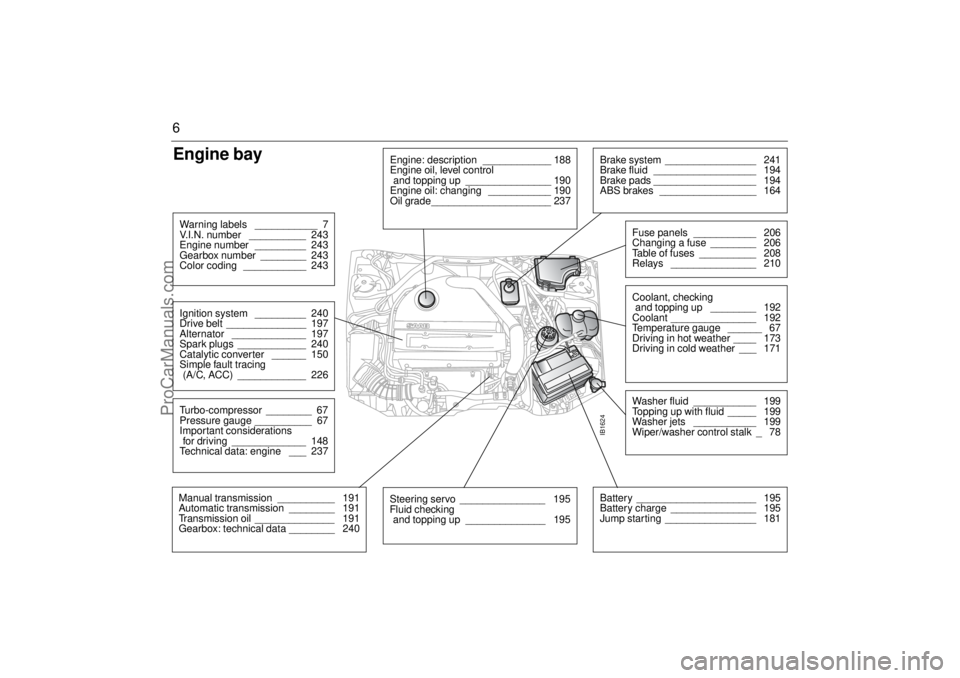
6Engine bayWarning labels ___________ 7
V.I.N. number __________ 243
Engine number _________ 243
Gearbox number ________ 243
Color coding ___________ 243Ignition system _________ 240
Drive belt ______________ 197
Alternator _____________ 197
Spark plugs ____________ 240
Catalytic converter ______ 150
Simple fault tracing
(A/C, ACC) ____________ 226Turbo-compressor ________ 67
Pressure gauge __________ 67
Important considerations
for driving _____________ 148
Technical data: engine ___ 237Manual transmission __________ 191
Automatic transmission ________ 191
Transmission oil ______________ 191
Gearbox: technical data ________ 240
Battery _____________________ 195
Battery charge _______________ 195
Jump starting ________________ 181IB1624
Engine: description ____________ 188
Engine oil, level control
and topping up _______________ 190
Engine oil: changing ___________ 190
Oil grade_____________________ 237
Washer fluid ___________ 199
Topping up with fluid _____ 199
Washer jets ___________ 199
Wiper/washer control stalk _ 78
Steering servo _______________ 195
Fluid checking
and topping up ______________ 195
Coolant, checking
and topping up ________ 192
Coolant _______________ 192
Temperature gauge ______ 67
Driving in hot weather ____ 173
Driving in cold weather ___ 171Fuse panels ___________ 206
Changing a fuse ________ 206
Table of fuses __________ 208
Relays _______________ 210
Brake system ________________ 241
Brake fluid __________________ 194
Brake pads __________________ 194
ABS brakes _________________ 164
ProCarManuals.com
Page 9 of 256

9
Jack– The jack is designed only for changing a tire or mount-
ing tire snow chains.
– Car must be level and jack must be placed on firm and
level ground.
– Never crawl under car while it is jacked up.
JACKING INSTRUCTIONS
1 Set parking brake and shift transmission to park.
2 Fit top of jack into jacking point next to wheel that to
be changed (See illustration).
3 Crank jack until so that car begins to lift.
4 Remove center cap by inser ting a screw driver under
cap prying up.
5 Using socket wrench in tool kit, loosen wheels bolts
one-half turn.
6 Raise car so that tire clears ground. Loosen wheel
bolts completely and remove wheel.
7 Mount spare wheel and tighten bolts enough so
wheel is not loose.
8 Lower car. Tighten wheel bolts in crosswise order
(See illustration).
Observe max. speed limit for spare tire.
IB934
Soft top, Saab 9-3
Convertible Push the handle in before
driving away.
There would otherwise be
a risk of injury.
Soft top, Saab 9-3 ConvertibleDo not lean over top or sit in the rear seat
while activated.
Brake fluidClean filler cap before removing. Use only Dot
4 fluid from sealed container.
ProCarManuals.com
Page 63 of 256
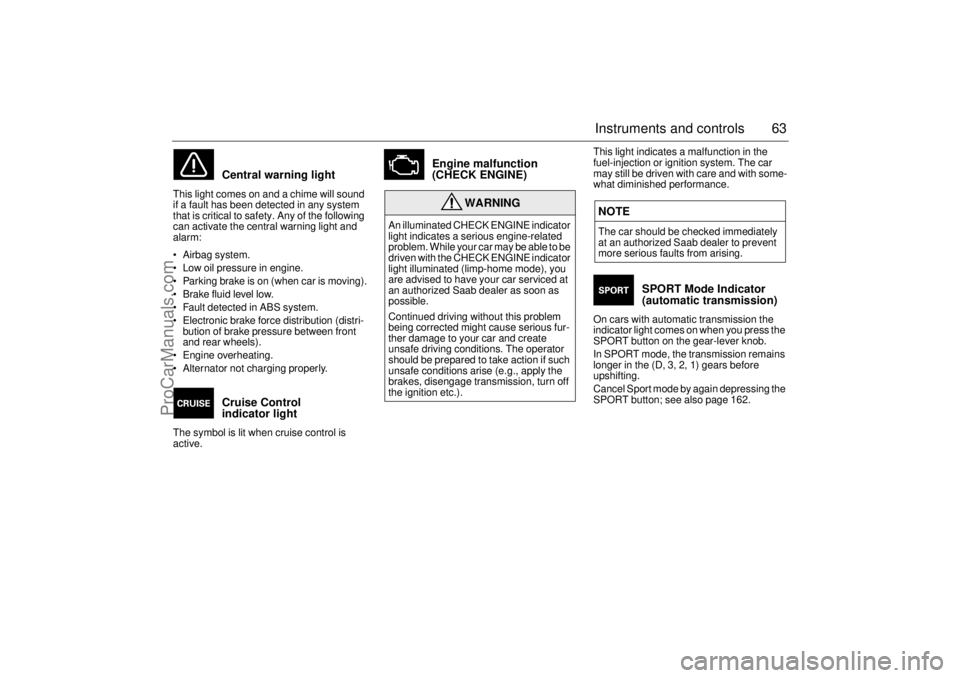
63 Instruments and controls
Central warning light
This light comes on and a chime will sound
if a fault has been detected in any system
that is critical to safety. Any of the following
can activate the central warning light and
alarm:
Airbag system.
Low oil pressure in engine.
Parking brake is on (when car is moving).
Brake fluid level low.
Fault detected in ABS system.
Electronic brake force distribution (distri-
bution of brake pressure between front
and rear wheels).
Engine overheating.
Alternator not charging properly.
Cruise Control
indicator light
The symbol is lit when cruise control is
active.
Engine malfunction
(CHECK ENGINE)
This light indicates a malfunction in the
fuel-injection or ignition system. The car
may still be driven with care and with some-
what diminished performance.
SPORT Mode Indicator
(automatic transmission)
On cars with automatic transmission the
indicator light comes on when you press the
SPORT button on the gear-lever knob.
In SPORT mode, the transmission remains
longer in the (D, 3, 2, 1) gears before
upshifting.
Cancel Sport mode by again depressing the
SPORT button; see also page 162.
WARNING
An illuminated CHECK ENGINE indicator
light indicates a serious engine-related
problem. While your car may be able to be
driven with the CHECK ENGINE indicator
light illuminated (limp-home mode), you
are advised to have your car serviced at
an authorized Saab dealer as soon as
possible.
Continued driving without this problem
being corrected might cause serious fur-
ther damage to your car and create
unsafe driving conditions. The operator
should be prepared to take action if such
unsafe conditions arise (e.g., apply the
brakes, disengage transmission, turn off
the ignition etc.).
NOTEThe car should be checked immediately
at an authorized Saab dealer to prevent
more serious faults from arising.
ProCarManuals.com
Page 64 of 256
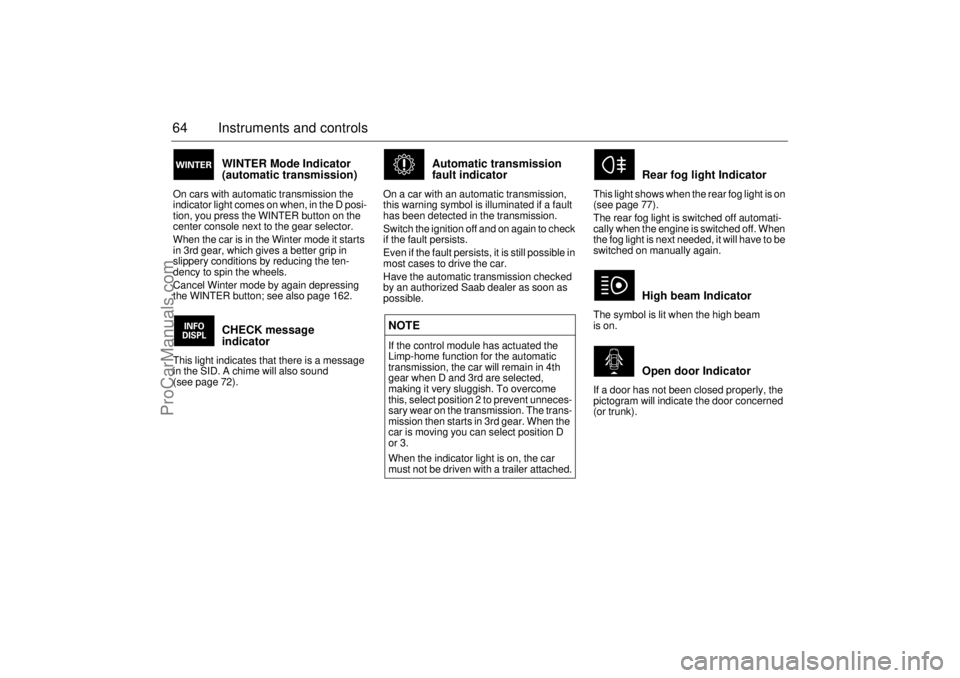
64 Instruments and controls
WINTER Mode Indicator
(automatic transmission)
On cars with automatic transmission the
indicator light comes on when, in the D posi-
tion, you press the WINTER button on the
center console next to the gear selector.
When the car is in the Winter mode it starts
in 3rd gear, which gives a better grip in
slippery conditions by reducing the ten-
dency to spin the wheels.
Cancel Winter mode by again depressing
the WINTER button; see also page 162.
CHECK message
indicator
This light indicates that there is a message
in the SID. A chime will also sound
(see page 72).
Automatic transmission
fault indicator
On a car with an automatic transmission,
this warning symbol is illuminated if a fault
has been detected in the transmission.
Switch the ignition off and on again to check
if the fault persists.
Even if the fault persists, it is still possible in
most cases to drive the car.
Have the automatic transmission checked
by an authorized Saab dealer as soon as
possible.
Rear fog light Indicator
This light shows when the rear fog light is on
(see page 77).
The rear fog light is switched off automati-
cally when the engine is switched off. When
the fog light is next needed, it will have to be
switched on manually again.
High beam Indicator
The symbol is lit when the high beam
is on.
Open door Indicator
If a door has not been closed properly, the
pictogram will indicate the door concerned
(or trunk).
NOTEIf the control module has actuated the
Limp-home function for the automatic
transmission, the car will remain in 4th
gear when D and 3rd are selected,
making it very sluggish. To overcome
this, select position 2 to prevent unneces-
sary wear on the transmission. The trans-
mission then starts in 3rd gear. When the
car is moving you can select position D
or 3.
When the indicator light is on, the car
must not be driven with a trailer attached.
ProCarManuals.com
Page 65 of 256
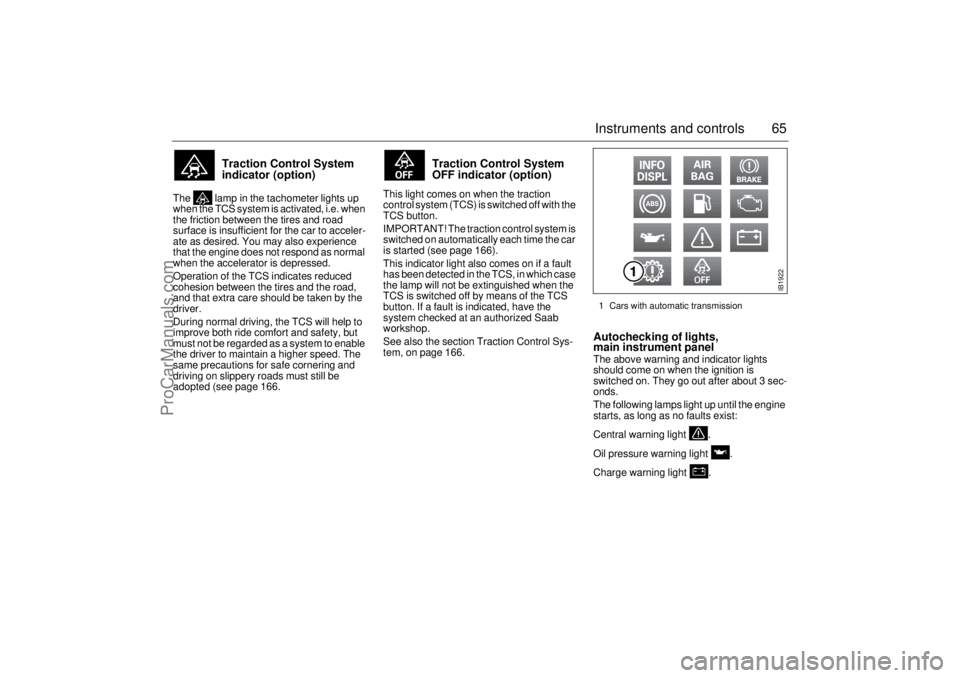
65 Instruments and controls
Traction Control System
indicator (option)
The lamp in the tachometer lights up
when the TCS system is activated, i.e. when
the friction between the tires and road
surface is insufficient for the car to acceler-
ate as desired. You may also experience
that the engine does not respond as normal
when the accelerator is depressed.
Operation of the TCS indicates reduced
cohesion between the tires and the road,
and that extra care should be taken by the
driver.
During normal driving, the TCS will help to
improve both ride comfort and safety, but
must not be regarded as a system to enable
the driver to maintain a higher speed. The
same precautions for safe cornering and
driving on slippery roads must still be
adopted (see page 166.
Traction Control System
OFF indicator (option)
This light comes on when the traction
control system (TCS) is switched off with the
TCS button.
IMPORTANT! The traction control system is
switched on automatically each time the car
is started (see page 166).
This indicator light also comes on if a fault
has been detected in the TCS, in which case
the lamp will not be extinguished when the
TCS is switched off by means of the TCS
button. If a fault is indicated, have the
system checked at an authorized Saab
workshop.
See also the section Traction Control Sys-
tem, on page 166.
Autochecking of lights,
main instrument panel The above warning and indicator lights
should come on when the ignition is
switched on. They go out after about 3 sec-
onds.
The following lamps light up until the engine
starts, as long as no faults exist:
Central warning light .
Oil pressure warning light .
Charge warning light .
IB1922
1 Cars with automatic transmission
ProCarManuals.com
Page 68 of 256
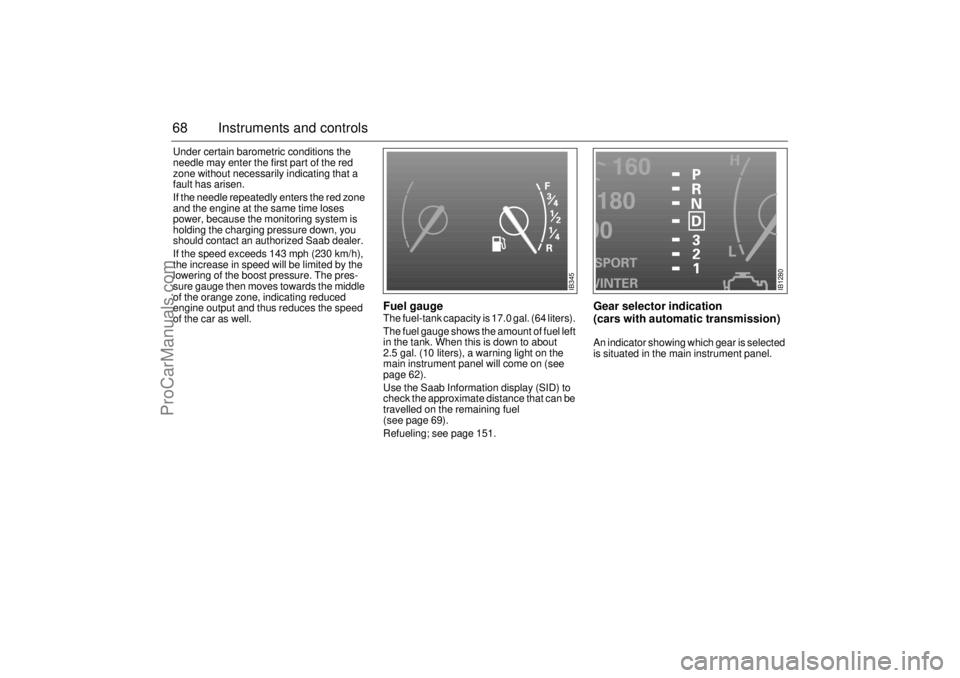
68 Instruments and controlsUnder certain barometric conditions the
needle may enter the first part of the red
zone without necessarily indicating that a
fault has arisen.
If the needle repeatedly enters the red zone
and the engine at the same time loses
power, because the monitoring system is
holding the charging pressure down, you
should contact an authorized Saab dealer.
If the speed exceeds 143 mph (230 km/h),
the increase in speed will be limited by the
lowering of the boost pressure. The pres-
sure gauge then moves towards the middle
of the orange zone, indicating reduced
engine output and thus reduces the speed
of the car as well.
Fuel gaugeThe fuel-tank capacity is 17.0 gal. (64 liters).
The fuel gauge shows the amount of fuel left
in the tank. When this is down to about
2.5 gal. (10 liters), a warning light on the
main instrument panel will come on (see
page 62).
Use the Saab Information display (SID) to
check the approximate distance that can be
travelled on the remaining fuel
(see page 69).
Refueling; see page 151.
Gear selector indication
(cars with automatic transmission)An indicator showing which gear is selected
is situated in the main instrument panel.
IB345
IB1280
ProCarManuals.com
Page 73 of 256

73 Instruments and controls
The following CHECK messages may be
displayed: 1) This message will be displayed approximately
600 miles (1,000 km) before the next sched-
uled service is due, or when 365 days have
elapsed since the last service. The message
should be cleared at the time of that service
(see the Saab Warranties & Service Record
Booklet).
This message can also be deleted by first
briefly pressing the CLR button, then depress-
ing it a second time for at least eight seconds
until "SERVICE" appears on the display and a
chime sounds. The message can only be
deleted when it is shown on the SID.
Night panelTo improve night-driving conditions inside
the car, the Night Panel mode can be
selected. In this mode, the amount of infor-
mation displayed is reduced, and only the
most important instruments and displays
will be illuminated.
When the Night Panel button is pressed,
only the speedometer will be illuminated (up
to the 87-mph or 140-km/h graduation), all
the other instruments illumination will be
extinguished and their needles moved to
zero. Both the SID and the ACC displays will
be extinguished and the backlighting for
switches and other controls will be dimmed.
Note: All indicator and warning lights,
together with the display of CHECK mes-
sages, will operate as normal. The following conditions will wake up the
respective displays in the Night-Panel
mode:
Setting of the Audio System, SID or ACC
(display comes on for ten seconds).
CHECK message generated in the SID.
High engine revs cause the rev counter to
be illuminated until the engine speed has
fallen again.
If the quantity of fuel remaining falls below
4 gallons (15 liters), the fuel gauge will be
illuminated.
If the engine temperature rises above nor-
mal, the temperature gauge will be illumi-
nated.
If the speed of the car exceeds 84 mph
(135 km/h), the entire speedometer will
be illuminated.
In cars with automatic transmission, if the
selector lever is moved from D to position
3, 2 or 1, the selector indication on the
main instrument panel will be illuminated.
To restore the displays and lighting to the
normal mode, press the Night-Panel button. Display shows: See
page
BRAKE LIGHT FAILURE 202
FRONT LIGHT FAILURE 200
REAR LIGHT FAILURE 202
FOG LIGHT FAILURE 203
WASHER FLUID LEVEL LOW 199
TIGHTEN FUEL FILLER CAP 151
FILL COOLANT FLUID 192
KEY NOT ACCEPTED 45
REPLACE KEY BATTERY 45
SERVICE THEFT ALARM 45
TRANSMISSION OVERHEATING 159
TIME FOR SERVICE
1)
230
ProCarManuals.com
Page 145 of 256
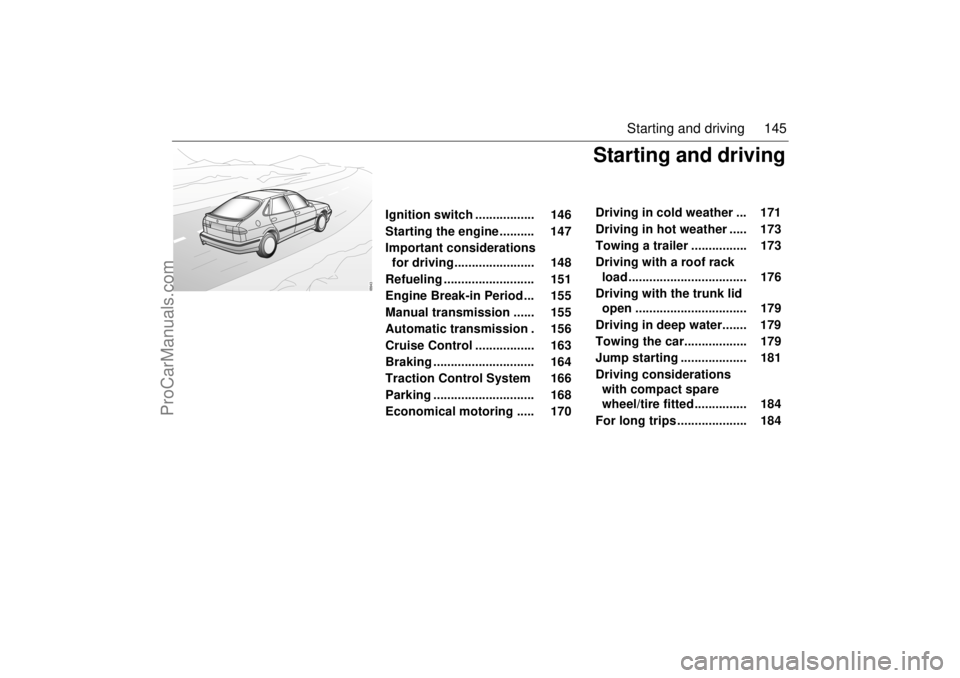
145 Starting and driving
IB943
Starting and driving
Ignition switch ................. 146
Starting the engine .......... 147
Important considerations
for driving....................... 148
Refueling .......................... 151
Engine Break-in Period... 155
Manual transmission ...... 155
Automatic transmission . 156
Cruise Control ................. 163
Braking ............................. 164
Traction Control System 166
Parking ............................. 168
Economical motoring ..... 170 Driving in cold weather ... 171
Driving in hot weather ..... 173
Towing a trailer ................ 173
Driving with a roof rack
load .................................. 176
Driving with the trunk lid
open ................................ 179
Driving in deep water....... 179
Towing the car.................. 179
Jump starting ................... 181
Driving considerations
with compact spare
wheel/tire fitted............... 184
For long trips .................... 184
ProCarManuals.com
Page 146 of 256
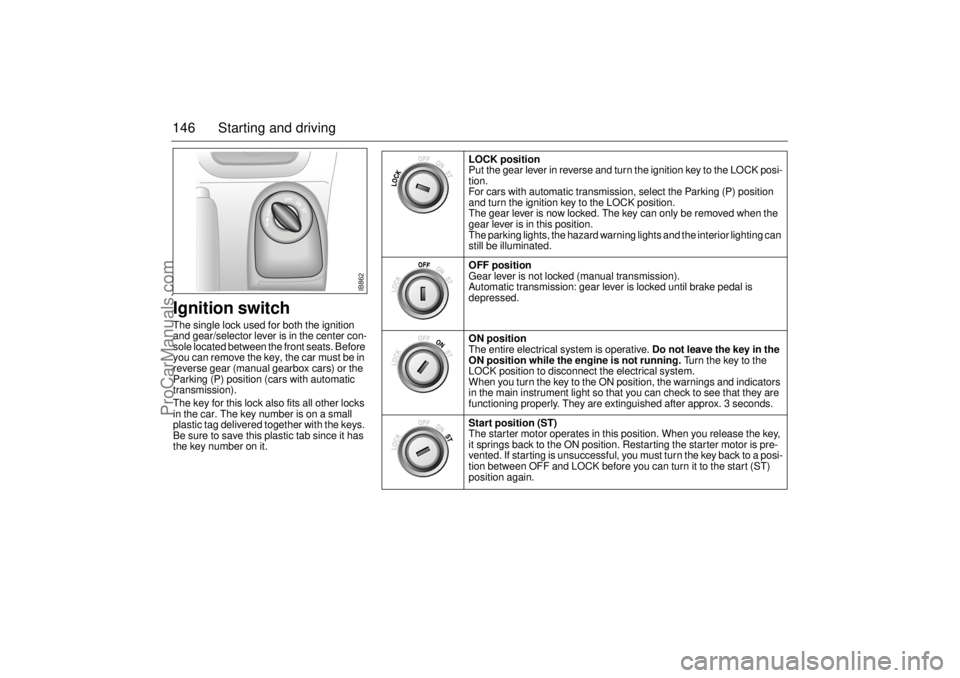
146 Starting and drivingIgnition switchThe single lock used for both the ignition
and gear/selector lever is in the center con-
sole located between the front seats. Before
you can remove the key, the car must be in
reverse gear (manual gearbox cars) or the
Parking (P) position (cars with automatic
transmission).
The key for this lock also fits all other locks
in the car. The key number is on a small
plastic tag delivered together with the keys.
Be sure to save this plastic tab since it has
the key number on it.
IB862
LOCK position
Put the gear lever in reverse and turn the ignition key to the LOCK posi-
tion.
For cars with automatic transmission, select the Parking (P) position
and turn the ignition key to the LOCK position.
The gear lever is now locked. The key can only be removed when the
gear lever is in this position.
The parking lights, the hazard warning lights and the interior lighting can
still be illuminated.
OFF position
Gear lever is not locked (manual transmission).
Automatic transmission: gear lever is locked until brake pedal is
depressed.
ON position
The entire electrical system is operative. Do not leave the key in the
ON position while the engine is not running. Turn the key to the
LOCK position to disconnect the electrical system.
When you turn the key to the ON position, the warnings and indicators
in the main instrument light so that you can check to see that they are
functioning properly. They are extinguished after approx. 3 seconds.
Start position (ST)
The starter motor operates in this position. When you release the key,
it springs back to the ON position. Restarting the starter motor is pre-
vented. If starting is unsuccessful, you must turn the key back to a posi-
tion between OFF and LOCK before you can turn it to the start (ST)
position again.
ProCarManuals.com